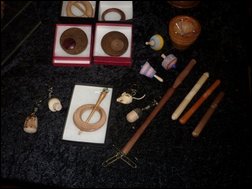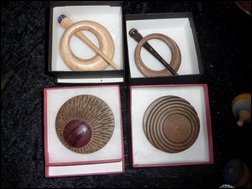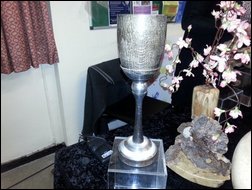Club Night Report
Wednesday 14th January 2015
The title of the talk and demonstration 'Turning on a Shoestring' was intriguing and inspired hope that it is possible to enjoy woodturning productively without plunging too deeply into the piggy bank. A jam-packed car park and a brimming roomful on a filthy night showed that members had tapped into the spirit of the occasion.
 |
 |
 |
 |
Items tackled at the lathe were as few as a tapestry worker's bobbin (larger than lace bobbins), an ornamental goblet component using a self-produced ingot of pewter, a scarf/shawl ring and a wooden pin to match the ring. These small things provided all the opportunity he needed to make his points about economy, design/shape, tool use, tool design and turning methods. He explained that as a professional turner his success depended on maximizing the differential between production cost and sale price.
Suggestions for economy included:
Scrounging around for pieces of wood, saving small pieces including offcuts and rescued oddments, looking for pieces containing contrasting colours, identifying unusual/unlikely varieties citing Ivy as an example, using the best pieces of scrap wood to challenge the imagination, focusing on and imagining the many small items that can be made from minor scraps, not discarding automatically wood that has been affected by worm, etc., etc.
 |
 |
Use modified and high quality open-ended spanners as cutting tools. They should be mounted in home-made handles to give greater length, grip and leverage. Only one tip needs to be ground to a cutting edge. This will be the top edge when contact is made. The other tip trails. A uniform dimension can be achieved along a length of spindle, but keep in mind that many spanners are not precision instruments and may produce a finished dimension up to ½ mm out from the expected diameter.
When mounting newly made handles on old tools any spaces can be tight-packed very effectively with a mixture of sawdust and superglue.
Make moulds for melted pewter from very dry Oak. Any moisture content in the wood will lead to spitting or worse when the molten metal is poured in. Allow pewter that has been mounted on a screw chuck time to cool after work; it will then unscrew readily.
Use 'Cascamite' to bond wood and pewter. (Safety Note: Pewter becomes very hot in work! Always wear goggles and ensure that skin is protected).
Keep an open mind on the shape of items in make. This advice runs counter to the principle held by some that turners should stick to drawings/designs and their dimensions. In practice, in hand turning it is perfectly possible to change a design as you go along if you see a preferable alternative shape or feature.
Use glue chucks. Having prepared a circular hardwood blank from which to make the scarf ring he would have mounted it by eye slightly off-centre on a glue chuck if the glue gun had not failed. Cutting out the centre on the lathe would then have resulted in a ring of variable rim width and very pleasing appearance.
For sanding the inside surface of the ring when removed from the wooden faceplate (and other items where appropriate) he turned a cylinder of say 1¼" diameter to which he showed how to attach abrasive sheet using double sided tape. He explained that there should be a good clearance between the abrasive and the ring to permit tilting and avoid sanding a flat inside surface on it. He also emphasized the need to make the abrasive sheet overlap in the right direction.
Red wine serves as an effective wood dye. Lemon juice can be used to turn Oak black. 'Plasticoat' is a very effective finisher when making items that must be 'food-safe'. Seven or eight coats should be applied to ensure that micropores in timber are completely filled or covered.
Some examples of Pete Moncrieff-Jury's work |
|
 |
 |
 |
 |
Grind tools to shape edges and bevel angles that suit you. You do not have to stick to set guidelines if you can work out your own preferences.
Good quality components such as those used in key rings are obtainable cheaply in bulk. Industrial magnets can be incorporated to advantage in turned pieces as can gemstones on the ends of such products as wooden pins. He showed small spinning tops into which he had incorporated high quality brass tips to improve both appearance and spin.
Sticking with the 'keep' rather than 'discard' principle he mounted neatly between centres the main section of the tapestry bobbin that had broken earlier and showed that it made a perfectly serviceable blank for a smaller item and that a spanner cutter would work well thereon.
Abrasives should never become hot in use; he learned this from a blind turner.
Bandsaw use can be reduced by converting square or uneven shaped blanks to round ones using gouges. His circa 4" square was given this treatment, and he went about ¾ of the way from right to left before removing the final section from left to right. Several passes were needed to achieve this but the end result was perfect.
Pete's presentation contained numerous other pieces of practical advice and background information about his personal development in turning, but this report focuses on the economic theme. His approach made an enjoyable change and had its own distinctive character which earned an enthusiastic round of applause at the end!
<Top of Page>
The Show and Tell - theme for the evening was: An Open Theme - an item that you are particularly pleased with...
Clearly, Mike Crawshaw cannot quite believe Bob Sawyer waxing lyrical about his winning entry - somewhat mangling Shakespeare's Hamlet with his "Alas poor Yorick, I knew him well". |
 |
| This month's Show and Tell winner was Bob Sawyer with a fine bowl complete with pewter rim. |  |
<Top of Page>
